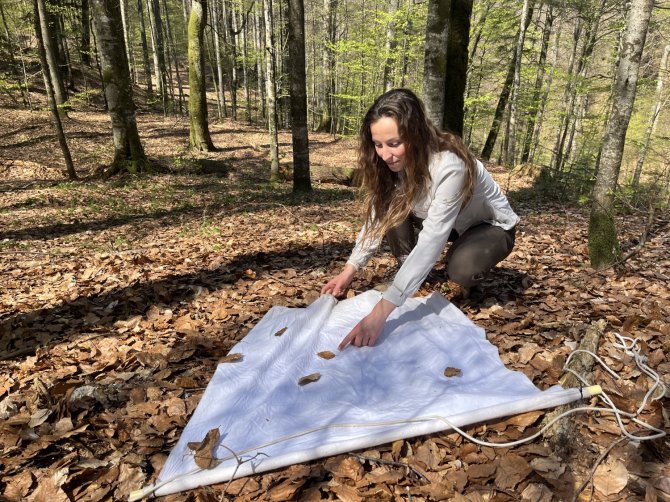Ecologists Helen Esser and Clara Köhler will travel to a Romanian primaeval forest this spring with game cameras and white sheets. They aim to map the relationship between ticks, rodents, and the forest's structure. Esser: 'We aim to discover how the forest's structure affects the risk of diseases caused by ticks, including in the Netherlands.'
Anyone walking or working out in the forest can easily get a tick bite, which may result in Lyme disease. Ticks also live in gardens and parks, which makes it easy to link more green to Lyme disease. Ticks make their way from shrubs to hikers' legs, after all. 'Still, claiming more green or greater biodiversity causes more ticks that transfer diseases is somewhat simplistic', says Helen Esser, assistant professor of disease ecology.

'It is not just about the tick that carries the Borrelia bacterium and other pathogens. There is a whole world behind these pathogens,' Esser explains. 'One could wonder whether more animals on which ticks feed occur in a more varied forest or greener environment?' Esser is to travel to Romania in April, where PhD candidate Clara Köhler starts a six-month stint in fieldwork. For this study, WUR collaborates with the RIVM (Dutch National Institute for Public Health and Environment) and the Romanian university of Cluj-Napoca.
Symposium: Paradigm shifts for Global One Health
During the international symposium Paradigm shifts for Global One Health, taking place from April 22nd to 25th in Wageningen, experts in the field of One Health convene. They will share knowledge about humans, animals, and ecosystems in relation to health.
From a very young to a very old forest
Esser talks about the study using the three main characters and the stage upon which this story unfolds. The stage is the Romanian Carpathians, where the forest ranges from very young and single-structured to very old and richly structured. The latter type has developed unchecked for hundreds of years. Romania is one of the last European countries to have such forests. Esser studies the trunk thickness, tree species and the thickness of the foliage along the full spectrum of this forest, as well as the smaller plants and brushwood that cover the ground. She will deploy game cameras and microphones to map the diversity in mammals and birds.
Next, Esser and Köhler search for the first main character, the tick. They drag white sheets through the vegetation to capture it. They then test the ticks' DNA for viruses and bacteria that can cause disease in humans. The second group of key players consists of young rodents, mainly mice and shrews, on which ticks feed. They transfer viruses and bacteria onto the ticks, who then transfer them to humans. The researchers will establish which of the mice and shrews are infected.
Transferal of disease
The third main character is required for the tick to reproduce. 'Ticks prefer to do so using the blood of large mammals such as deer', Esser explains. 'So, it is a complex interaction between various animals in the forest that influences the number of infected ticks. We want to figure out the details.'
Ultimately, Esser and Köhler want to know how many ticks are found in each type of forest and what percentage is infected. This will then be offset against the biodiversity of wild animals and the structure of the forest. Thus, they hope to see what conditions pose the greatest risk of diseases being transferred to humans. Esser: 'We expect a higher diversity will increase the risk of disease transferral, while the risk should become less in the most diverse forests due to the competition between different animal species and more predators who eat mice.'
Forests and cities in the Netherlands
The ancient forests the ecologists will study are almost exclusively found in Romania. They have ceased to exist in the Netherlands. Esser: 'Moreover, humans have a much greater influence on Dutch forests through, for example, logging, hunting and feeding. Still, the results are relevant here since there are policies in place to make forests more diverse. That means you must know how this impacts the risk of diseases transferred by ticks. We may discover that particular measures reduce the risk, which could prove useful for the Netherlands and other European countries.'
What about green cities? 'Let's not forget that green in urban areas offers an abundance of advantages. Green leads to increased biodiversity, leisure, and cooling and helps store water in periods of drought', Esser states. 'A greener city is, however, not without risk because more green also means more ticks that may carry the Borrelia bacteria. That is something that should also be mentioned, in addition to all the advantages.'






